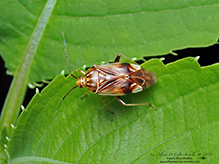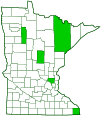lygus bug
(Lygus vanduzeei)
Conservation • Description • Habitat • Ecology • Distribution • Taxonomy
|
|
||||||||||||||
Description |
Lygus vanduzeei is a small, native, plant bug. It occurs in the United States from Maine to North Carolina, west to South Dakota and Illinois. It occurs in southern Canada from Nova Scotia to Saskatchewan. Adults are active from late May to early October. They feed on Canada goldenrod, probably other species of goldenrod, and possibly brambles (Rubus spp.). Adult males are ¼″ (6.50 mm) in length and ⅛″ (3.30 mm) wide. Females are ¼″ (6.40 mm) in length and ⅛″ (3.40 mm) wide. The body is oval and soft. The color and the darkness are variable. The body is whitish, greenish white, or brownish white (pale); with brown, yellowish brown, or reddish brown (dark) markings; and black spots and shading. The head is light yellowish brown or green, and it is slanted forward. The compound eyes are large. There are no simple eyes (ocelli). There is a prominent raised ridge (carina) between the eyes. The face has no grooves, no ridges, and no dark stripes. The mouth parts are optimized for piercing and sucking. They take the form of a long, 4-segmented beak. It is mostly pale, blackish just at the tip. When not used, the beak extends from the front of the head, along the underside of the body between the legs, to the tip of the first segment (coxa) of the hind legs. The antennae are slender, thread-like, and short. They have 4 segments. The second segment is shorter than the width of the head. The exoskeletal plate covering the first segment of the thorax (pronotum) is widest at the base and much narrower behind the head. It has a distinct, exposed collar in front, and the rear angles are rounded. There is a small, rounded tubercle (callus) at the front outer angle on each side of the pronotum behind the collar. The pronotum is pale. There is a black spot behind each callus, and a broad, diffuse, dark, longitudinal stripe extending from the spot to the rear margin. On dark individuals there are two black spots behind each callus. There is also a black spot at each rear corner of the pronotum. The surface of the pronotum is densely pitted (punctate) with coarse, dark punctures. The exoskeletal plate between the wing bases (scutellum) is large and triangular. It is mostly dark, but it is pale at the tip, and there is a pale dash on each side near the base. There are two pairs of wings. The front wings (hemelytra) are longer than the hind wings and a little longer than the body. They are held flat over the body when at rest. They are shiny and pale with a highly variable amount of dark and black shading. The surface is densely punctate. The hemelytra have a thickened, leathery part at the base and a thin membranous part at the tip with a clear dividing line between the two. The thickened part is comprised of the narrow area (clavus) behind the scutellum when the wings are closed, and the broad marginal area (corium). At the end of the corium there is a small but distinct triangular area (cuneus). The clavus is mostly dark. The corium is mostly pale. There is always a short, narrow, pale stripe on the inner margin at its widest point, which is near the tip of the membrane. The cuneus is pale. It has a dark, crescent-shaped band near the top, and the tip is black. The membrane is blackish with a pale spot on each side behind the cuneus. The veins are pale and they moderately to faintly contrast with the dark membrane. The hind wings are thin and membranous. The legs are pale and relatively long. On the hind legs, the outer (posterior) half of the third leg segment (femur) is dark or at least somewhat darkened, and there are one or two pale rings near the tip. |
Size |
Female total length: ¼″ (6.40 mm) Male total length: ¼″ (6.50 mm) |
Similar Species |
Habitat |
|
Ecology |
Season |
Late May to early October |
Behavior |
|
Life Cycle |
|
Nymph Hosts |
|
Adult Food |
|
Distribution |
||
|
Sources |
|
| 1/29/2025 | ||
Occurrence |
||
|
||
Taxonomy |
|
Order |
Hemiptera (True bugs, Hoppers, Aphids, and Allies) |
Suborder |
Heteroptera (True Bugs) |
Infraorder |
Cimicomorpha |
Superfamily |
Miroidea |
Family |
|
Subfamily |
Mirinae |
Tribe |
Mirini |
Genus |
Lygus (lygus bugs) |
Subordinate Taxa |
|
|
|
Synonyms |
|
Lygus lineolaris ssp. vanduzeei |
|
Common Names |
|
This species has no common name. The common name for the genus Lygus is lygus bugs, and it is applied here for convenience. |
|
Glossary
Carina
An elevated keel or ridge.
Coxa
The first (most proximal) segment of the legs of most arthropods, including all insects, spiders, and crustaceans, and most arachnids. It attaches the leg to the body and connects to the trochanter. Plural: coxae.
Femur
On insects and arachnids, the third, largest, most robust segment of the leg, coming immediately before the tibia. On humans, the thigh bone.
Hemelytron
The forewing of true bugs (order Hemiptera), thickened at the base and membranous at the tip. Plural: hemelytra.
Ocellus
Simple eye; an eye with a single lens. Plural: ocelli.
Pronotum
The exoskeletal plate on the upper side of the first segment of the thorax of an insect.
Punctate
Dotted with pits (punctures), translucent sunken glands, or colored spots of pigment.
Scutellum
The exoskeletal plate covering the rearward (posterior) part of the middle segment of the thorax in some insects. In Coleoptera, Hemiptera, and Homoptera, the dorsal, often triangular plate behind the pronotum and between the bases of the front wings. In Diptera, the exoskeletal plate between the abdomen and the thorax.
Tubercle
On plants and animals: a small, rounded, raised projection on the surface. On insects and spiders: a low, small, usually rounded, knob-like projection. On slugs: raised areas of skin between grooves covering the body.
Visitor Photos |
||
Share your photo of this insect. |
||
This button not working for you? |
||
Alfredo Colon |
 |
MinnesotaSeasons.com Photos |
||
|
||
|
||

Slideshows |
|

Visitor Videos |
||
Share your video of this insect. |
||
This button not working for you? |
||
|
Other Videos |
||
|

|
Created: 1/29/2025 Last Updated: © MinnesotaSeasons.com. All rights reserved. |


